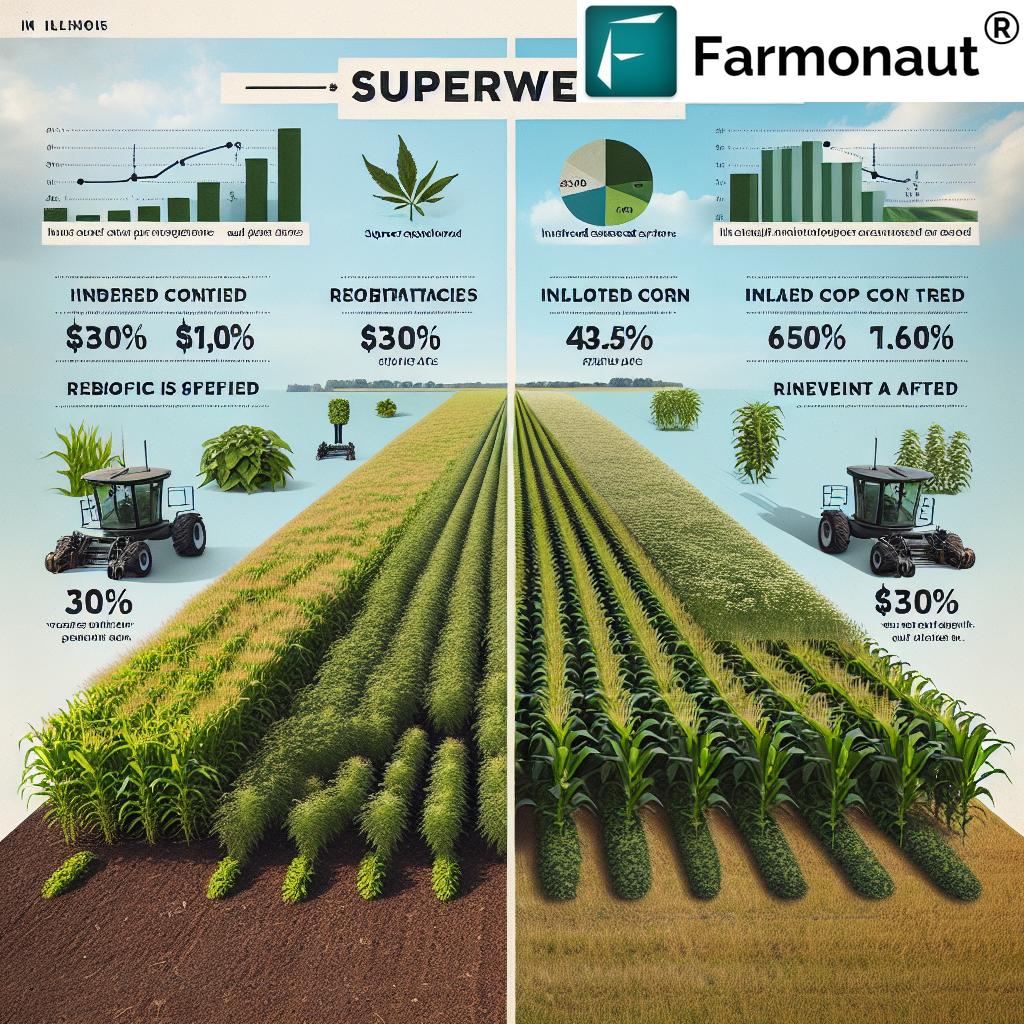Revolutionizing Illinois Farms: AI-Driven Robots Combat Superweeds for Sustainable Agriculture

“AI-driven farming robots can reduce herbicide use by up to 90% in corn production, promoting sustainable agriculture.”
In the heart of America’s Corn Belt, a revolution is taking root. Illinois farms are at the forefront of a technological transformation that promises to reshape the landscape of agriculture as we know it. The culprit? Superweeds. The solution? AI-driven robots that are changing the game in weed management and sustainable farming practices.
As we delve into this exciting new frontier, we’ll explore how robotic weed control and herbicide-resistant crops are revolutionizing sustainable agriculture technology. We’ll uncover the latest research on AI-driven farming robots and their potential to combat superweeds in corn production, offering an environmentally friendly alternative to traditional chemical herbicides.
The Rise of Superweeds: A Growing Threat to Illinois Farms
Before we dive into the innovative solutions, let’s understand the problem at hand. Superweeds, particularly waterhemp in Illinois corn fields, have become a significant challenge for farmers. These herbicide-resistant plants have evolved to withstand traditional chemical treatments, threatening crop yields and farmer profits.
- Superweeds can reduce corn yields by up to 50%
- Herbicide resistance has spread to over 250 weed species globally
- The cost of managing resistant weeds in the US is estimated at $4 billion annually
The increasing prevalence of superweeds has forced farmers and researchers to seek alternative weed management strategies. This is where AI-driven farming robots enter the scene, offering a precision agriculture solution that addresses the growing threat of herbicide resistance.
AI-Driven Farming Robots: The Future of Weed Control
Robotic weed control represents a significant leap forward in sustainable agriculture technology. These AI-powered machines use advanced sensors and machine learning algorithms to identify and target weeds with pinpoint accuracy, drastically reducing the need for broad-spectrum herbicides.

Key advantages of AI-driven farming robots include:
- Precision targeting of weeds, minimizing damage to crops
- Significant reduction in herbicide use, promoting environmental sustainability
- Ability to work around the clock, increasing efficiency
- Data collection for improved farm management decisions
These smart farming techniques are not just a futuristic concept; they’re already being implemented in Illinois farms, showcasing the potential of agricultural robotics adoption.
Weed Management Strategies: Myopic vs. Forward-Looking Approaches
Recent research has shed light on two distinct weed management strategies employed by farmers: myopic and forward-looking approaches. Understanding these strategies is crucial for grasping the long-term implications of agricultural robotics adoption.
Myopic Approach
Farmers using a myopic approach focus on short-term solutions, often relying heavily on chemical herbicides to combat weeds. While this method may provide immediate results, it can lead to:
- Increased herbicide resistance in weeds
- Higher long-term costs due to escalating herbicide use
- Potential environmental damage from chemical runoff
Forward-Looking Approach
In contrast, farmers employing a forward-looking strategy take a long-term view of weed management. These farmers are more likely to:
- Adopt agricultural robotics early
- Integrate smart farming techniques for sustainable weed control
- Invest in integrated weed control systems that combine multiple methods
“Forward-looking farmers are 3 times more likely to adopt agricultural robotics early for long-term sustainability and profitability.”
The research indicates that forward-looking farmers are better positioned to reap the benefits of technological advancements in agriculture, including improved long-term profitability and sustainability.
The Impact of AI-Driven Robots on Corn Production in Illinois
Illinois, known for its vast corn fields, is an ideal testing ground for AI-driven farming robots. The implementation of these advanced machines is showing promising results in combating superweeds and improving overall crop management.
- Reduced herbicide use: AI robots can cut herbicide application by up to 90%
- Improved crop yields: Precision weed control leads to healthier corn plants
- Cost savings: Lower input costs for herbicides and labor
- Environmental benefits: Decreased chemical runoff into waterways
These benefits align perfectly with the goals of sustainable agriculture, making robotic weed control an attractive option for Illinois farmers looking to future-proof their operations.
Comparing Weed Management Strategies
| Weed Management Strategy | Environmental Impact (1-10) | Cost Efficiency | Long-term Sustainability (years) |
|---|---|---|---|
| Chemical Herbicides | 8 (High impact) | Moderate (increasing over time) | 5-10 |
| AI-Driven Robotic Weed Control | 2 (Low impact) | High (80% savings over time) | 20+ |
| Integrated Approach (Chemicals + Robotics) | 4 (Moderate impact) | High (60% savings over time) | 15-20 |
This comparison clearly illustrates the advantages of AI-driven robotic weed control in terms of environmental impact, cost efficiency, and long-term sustainability.
The Role of Herbicide-Resistant Crops
While AI-driven robots are at the forefront of this agricultural revolution, herbicide-resistant crops also play a crucial role in integrated weed management strategies. These genetically modified crops are designed to withstand specific herbicides, allowing for more targeted weed control.
However, the widespread use of herbicide-resistant crops has contributed to the evolution of superweeds. This paradox highlights the need for a more holistic approach to weed management that combines multiple strategies, including robotic weeding and crop rotation.
Precision Agriculture Solutions: Beyond Weed Control
The benefits of AI-driven farming robots extend beyond weed management. These machines are part of a broader suite of precision agriculture solutions that are transforming farming practices. Some additional applications include:
- Automated planting and harvesting
- Precision fertilizer application
- Crop health monitoring
- Soil analysis and management
By integrating these smart farming techniques, Illinois farmers can optimize their operations, reduce resource waste, and increase overall productivity.
The Economics of Agricultural Robotics Adoption
While the benefits of AI-driven farming robots are clear, the economics of adoption play a crucial role in their widespread implementation. Researchers are studying the factors that influence farmers’ decisions to invest in this technology.
- Initial investment costs vs. long-term savings
- Farm size and scale considerations
- Potential for increased profits through improved yields and reduced input costs
- Government incentives and support for sustainable agriculture practices
As the technology matures and becomes more accessible, we expect to see increased adoption rates across Illinois and beyond.
The Spread of Robotic Weeding Technology
The adoption of robotic weeding technology is not limited to individual farms. Its impact is spreading across neighboring fields and entire agricultural regions. This diffusion of innovation has several implications:
- Reduced weed pressure on a regional scale
- Sharing of best practices among farmers
- Potential for cooperative ownership of expensive equipment
- Creation of new job opportunities in agricultural technology
As more farmers in Illinois embrace this technology, we anticipate a ripple effect that could transform the entire agricultural landscape of the state.
The Future of Farming: Integrating AI and Robotics
As we look to the future of farming in Illinois and beyond, it’s clear that AI and robotics will play an increasingly important role. The integration of these technologies promises to address some of the most pressing challenges in agriculture, including:
- Climate change adaptation
- Labor shortages
- Food security concerns
- Sustainable resource management
By embracing these innovations, Illinois farmers are not just combating superweeds; they’re paving the way for a more sustainable and productive agricultural future.
Farmonaut’s Role in the Agricultural Revolution
As we discuss these groundbreaking advancements in agricultural technology, it’s worth noting the contributions of companies like Farmonaut. While not directly involved in robotic weeding, Farmonaut offers complementary digital agri solutions that align with the goals of precision agriculture and sustainable farming.
Farmonaut’s satellite-based farm management solutions provide valuable tools for crop health monitoring, resource management, and data-driven decision-making. These technologies work hand-in-hand with robotic weeding systems to create a comprehensive approach to modern farm management.
Explore Farmonaut’s innovative solutions:
For developers interested in integrating Farmonaut’s technology into their own solutions, check out the API and API Developer Docs.
FAQs About AI-Driven Robotic Weed Control
- Q: How effective are AI-driven robots in controlling superweeds?
A: AI-driven robots have shown remarkable effectiveness in controlling superweeds, with some studies reporting up to 90% reduction in herbicide use while maintaining or improving weed control efficacy. - Q: Are these robots cost-effective for small farms?
A: While the initial investment can be significant, many small farms are finding ways to make robotic weed control cost-effective through cooperative ownership or custom services. Long-term savings on herbicides and labor often outweigh the initial costs. - Q: How do AI-driven robots identify weeds from crops?
A: These robots use advanced computer vision and machine learning algorithms to distinguish weeds from crops based on factors like plant shape, size, and color. The AI is continuously learning and improving its accuracy over time. - Q: Can robotic weed control completely replace chemical herbicides?
A: While robotic weed control significantly reduces the need for chemical herbicides, most experts recommend an integrated approach that combines multiple weed management strategies for optimal results. - Q: How does robotic weed control contribute to sustainable agriculture?
A: Robotic weed control promotes sustainability by reducing chemical use, minimizing soil disturbance, conserving water, and decreasing the carbon footprint associated with traditional weed management practices.
Conclusion: Embracing the Future of Agriculture
The rise of AI-driven robots in combating superweeds marks a pivotal moment in the history of agriculture. For Illinois farms and beyond, this technology offers a path towards more sustainable, efficient, and profitable farming practices. As we’ve explored, the adoption of robotic weed control and other precision agriculture solutions is not just about managing weeds; it’s about reimagining the entire approach to crop production.
The forward-looking farmers who embrace these innovations today are setting themselves up for success in the agricultural landscape of tomorrow. By integrating AI-driven robots, herbicide-resistant crops, and comprehensive digital farming solutions like those offered by Farmonaut, farmers can tackle the challenges of superweeds while promoting long-term sustainability.
As we look to the future, it’s clear that the synergy between human expertise and artificial intelligence will play a crucial role in feeding a growing global population while preserving our planet’s resources. The revolution in Illinois farms is just the beginning of a wider transformation in agriculture, one that promises to make farming smarter, greener, and more resilient than ever before.















